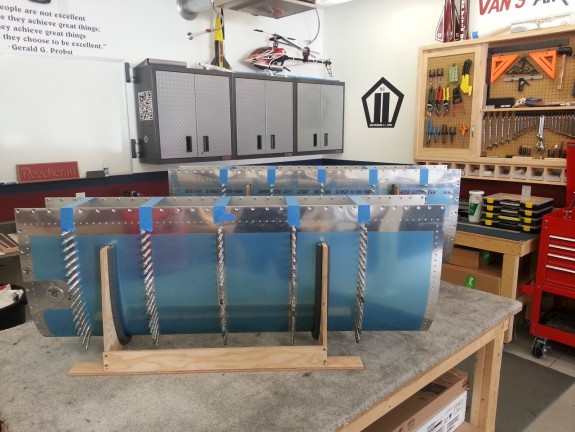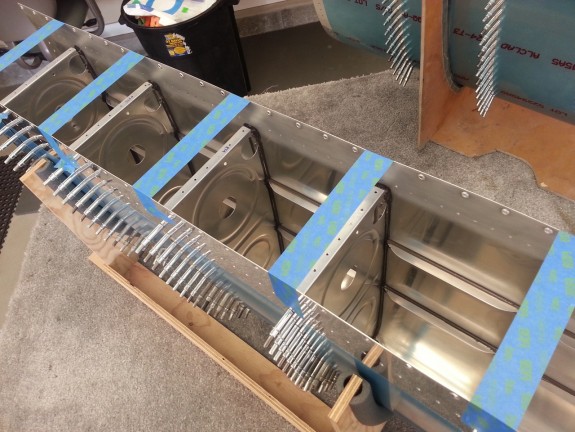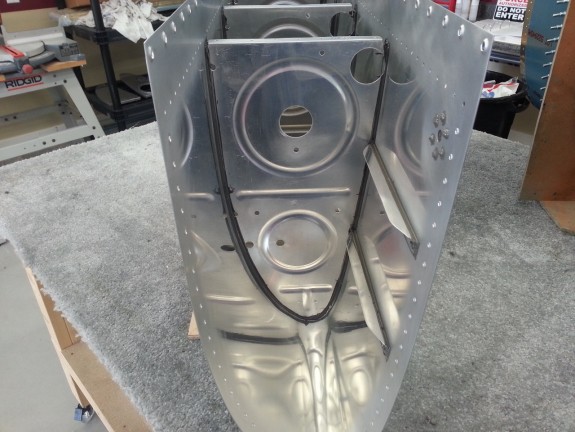Tank Ribs Sealed to Skin
Well, I finally bit the bullet and decided to get the ribs installed/sealed in the tank skins. For some time, I have not been enthused about the prospect. I just do not like ProSeal. Then again, I do not like caulking, drywall finishing, epoxying, or any other fluid type process (to include biologic). ProSeal does come with some distaste in the RV world, so I feel OK not being alone.
Some time ago, I read a thread on VansAirforce.net written by a guy named Rick Galati addressing this very ProSeal myth. I reread it several times leading up to just knocking it out. His general idea is to butter up the ribs, cleco them 100%, let set a few days, then rivet them together. This allows you to let the majority of the ProSeal get tacky or even light set, then all you have to worry about is wet setting the rivets (placing a dab of sealant in the countersink and inserting the rivet), then coming back and encapsulating the shop head in sealant to finish the task. You can click the link to get right to the thread.
After getting up the confidence and after taking care of a few household tasks, I headed out to the shop. I gathered all the materials, counted out the number of clecos, and cleaned all the parts. It was now or never. Armed with some 6 oz. ProSeal cartridges, a Semco sealant gun borrowed from another builder, and a ton of gloves, I started in on the right tank.
Process as follows:
- First, butter up the flange of a rib, then cleco it to the skin on the top with 5 clecos.
- Once all ribs are clamped into the skin, slide the skin into the cradle and begin clecoing the bottom starting at the leading edge with 5 clecos.
- Then cleco the rest of the holes until all are filled.
- This causes some squeeze out of the sealant to occur.
- Waited for about 5 minutes and then begin to smooth the squeeze out with a popsicle stick or in my case, a sealant spoon (donated to me by the same builder friend I borrowed the Semco gun from, THANKS TODD!).
- In places where the squeeze out is a little light, simply apply more ProSeal where needed (this is easy with the semco gun) and smooth.
Turns out, the 6 oz. cartridge size is just enough to do one tank worth of ribs. I blew through a couple of towels as I smoothed the fillets and wiped that sealant spoon. ProSeal is MESSY!
As you can see from the above picture, the web side of the ribs have pretty nice looking fillets. The flange side…well, not so much. Are they sealed though? I think so, and did all I could to make sure there was a continuous seal all around the flange. The sealant is especially messy at the nose of the ribs. The trick is to seal, not make pretty. Since this is not something anyone can see, I think it will be just fine. The true artists can do a great job, I just don’t want to have any leaks. Any light spots discovered later can be managed with more sealant after it is all set and before the baffle is sealed into place.
I repeated the process with the left tank. There was 1 rib flange at the forward most top hole that was not sitting right. Rather than take apart the whole tank to get at it, I decided to rivet that hole right away. I took a piece of flexible fuel line (rc airplane type) and placed it over a MEK cleaned rivet tail and set it. It pulled the flange right into place.
Once both tanks were done, I taped over each end of the rib to pull the skin closer together. The bend in the skin makes it splay away from the rib flange. Not a problem once the baffle is installed, but at this stage, I just felt better pulling them in to set the flanges where they should be while the sealant cured.
Next up, I need to buy some more sealant and get ready to rivet the tanks final. I am glad to have this step behind me. Please…NO LEAKS!












